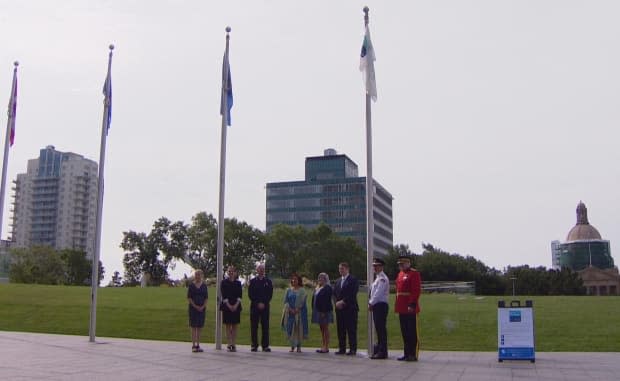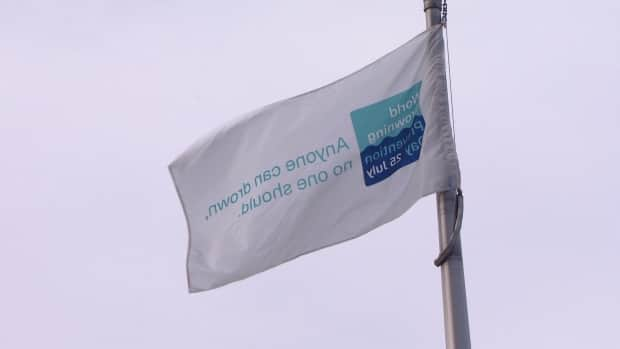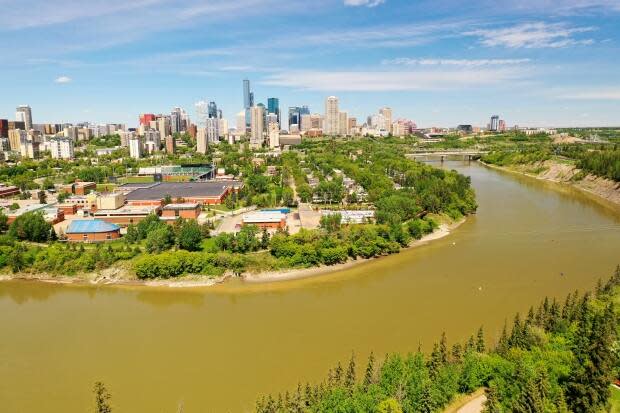Alberta marks 1st annual World Drowning Prevention Day

A special flag raising ceremony was held Sunday morning outside the Federal Building in Edmonton to mark the first annual United Nations-recognized World Drowning Prevention Day.
On hand were a collection of first responders, MLAs and Alberta's lieutenant-governor.
The flag will be flown every July 25 to observe the tragic and profound impact drownings have on families and communities as well as highlight lifesaving solutions to prevent them.
Kelly Carter, CEO of the Lifesaving Society Alberta and Northwest Territories, said the UN declaration comes at a dire time as the province sees more drownings this year than in the past two decades.

"It's really important that we get awareness out there for Albertans to change their behaviour but also to be aware of how to be water smart when they're recreating in, on and around the water," he said.
Alberta RCMP officers have responded to the drowning deaths of 95 people in the last five years.
Assistant Commissioner John Ferugson said 16 of those drownings have occurred in the first seven months of 2021.
"Many times the hardest part to accept about these tragedies is that they could have been prevented with increased water safety knowledge and more widespread use of water safety equipment," he said.
That's the idea behind the UN General Assembly's historic resolution on global drowning prevention, which passed on April 28 this year.
Ferguson said he's hopeful that adopting a day of awareness will help to prevent future tragedy.
A recent analysis by the Lifesaving Society and the Injury Prevention Centre at the University of Alberta looked at drowning data in Alberta over the past 20 years.
It found, on average, for every fatal drowning there are six more non-fatal drownings that result in emergency department visits or hospital admissions.
Society president Sean Curran said that all adds up to a deeply concerning and wholly preventable cost.
"The economic cost of drownings in Alberta over the past 20 years is estimated to be around 25 million dollars," he said.
Contributing factors
Speakers pointed to a number of reasons contributing to the increased number of drownings this year, including the recent heatwave that forced many Albertans to rivers and lakes to cool off.
Pandemic restrictions over the past year and half have also played a role with the closure of recreation centres.
Carter said an especially concerning statistic is that an estimated 200,000 Alberta students didn't get the chance to take swim lessons.
"That definitely increases the risk because people haven't learned swim survival skills," he said, adding that those who learned previously may also have become rusty and less confident.

Edmonton Fire Rescue Services Chief Joe Zatylny said water rescue calls are on the rise. He said Edmonton fire reported 104 water rescue events last year — but have already responded to 110 between Jan. 1 and July 19 this year.
Zatylny said calls are especially prevalent along the North Saskatchewan River. He said the swift water can make for dangerous conditions, even for first responders, and is warning residents not to attempt a rescue on their own.
"Our crews have special training and equipment and are ready to help citizens in need. Please call 911 immediately and keep your eye on the person or animal but do not go in after them."
First responders are encouraging everyone to keep some safety tips in mind to stay as safe as possible around the water.
Those include wearing a life jacket, not swimming alone, avoiding alcohol and cannabis, and having an outdoor plan before heading out, like considering water and weather conditions and the skill level of those involved.

